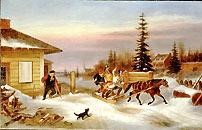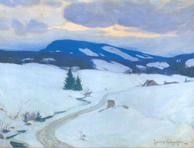Table of Contents
Section 1: A Focus on Cornelius Krieg off The Toll Gate, c. 1863 Oil on canvas

Figure 1: Cornelius Krieg off the Toll Gate, c. 1863 Oil on canvas, 30.1 x 52.8 cm, Collection: Montreal Museum of Fine Arts
The art by Cornelius Krieghoff depicts horse pulling carriage ferrying some people and luggage. An equestrian, who is also accompanied by a dog, controls the horse. The featured landscape is snowed. A look at the art brings out the lifestyle of the society and landscape at the time and impresses the notion Romanticism.
The artist employed painting and drawing, abstracting and making figures, mixing contemporary discourses, and perspectives with traditional art. The artist integrated social commentary on his art as a way of enhancing truths concerning an individual, while presenting the way of life of people at the time. The artist artistic style was mainly comprised of scribbling and use of drawing and diagrams depicting imageries.
The artist’s artistic subjects comprised of elements within his Caribbean heritage, extending further to cover some of the elements of the African-American culture and the Aztec history. The artist’s work also covered elements of the classical themes and celebrities of the contemporary societies such as the musicians and athletes. The artist’s work can be considered as masterpieces that created the allowance to express the way of life of other cultures.

The artist integrated various traditions, styles, and practices and turned them into an attractive art, some of which he derived from the society heritages and other parts of the world. Harper has described artist’s work as an example of neo-expressionism in which the artists re-integrated the human figures into art after a long-felt dominance of stringent forms of conceptualism and minimalism; thereby, forming an association with Romanticism.
Section 2: Clarence A. Gagnon Twilight in the Laurentians, Winter c. 1910 Vs Cornelius Krieghoff the Toll Gate, c. 1863

Figure 2: Clarence A. Gagnon Twilight in the Laurentians, winter c. 1910 Oil on canvas, and 51.1 x 66.7 cm Heffel Gallery Limited
The art by Clarence A. Gagnon, Twilight in the Laurentians depicts a road that winding through the Laurentian on course of the winter period. In essence, the art was aimed at expressing the fascinating nature of the surrounding. A comparison of Clarence A. Gagnon Twilight in the Laurentians and Cornelius Krieghoff the Toll Gate reveals the focus landscape appealing nature integrating the Romanticism concepts.
Both paintings notably happen to depict the nature and landscape of the Canadian environment. While Cornelius Krieghoff goes beyond the snow environment to include people’s lifestyle, Clarence A. Gagnon happens to focus on the appeals of the snowed landscaped in the Laurentian, featuring the mountain and its valleys. As documented by Appignanesi et al, Romanticism describes a forms of painting art movement comprising of a new diverse styles of art work that spurred new perspectives in art that influenced the rest of the world. Appignanesi has described ‘Romanticism’ as a term that befitted a description of an art movement that not only encompassed forms of painting that charmed canvases with an assortment of colors and abstract forms, but also paintings that integrated gestural expressionism. Nevertheless, Romanticism has also been described as a movement characterized by various groups of artists who had one thing in common such as creating expressive forms of art laden with profound emotions and universal themes. Romanticism was certainly shaped by different ideas that inspired them to appreciate and treasure pieces of art that reflect the personal experiences, ideas, and perspectives.
Response to Section 3
The additional elements that can be discerned from the two pieces of art does not only focus on the appealing nature of the snow landscape, but also the medium painting techniques of use of oil and canvas that conform to the artistic techniques of Romanticism.
The paintings depicts a gestural abstraction, where paint was applied on the canvas and manipulated to reflect the inner mind of the artist. The colors used are expressive. The art space is created using various alternating layers of opaque paint, creating a texture of canvass with motional hue. Furthermore, Romanticism art pieces must be laden with profound emotions and universal themes of cultural change. Moreover, another outstanding element is the medium by which the art is encrypted. Both pieces use oil on canvas.
Considering many artists reached maturity in the 19th Century, they welcomed cultural expressionism. This form of art was particularly lauded for being an emphatic reflection of modern society’s spirit — it was filled with a romantic mood and expressed a rugged form of individual freedoms, as much as it was monumental in terms of scale. Furthermore, the movement was more about painting. The social upheavals that took place in Europe during the time also spurred revolution in art. Romanticism encouraged artists to cultivate interests in the archetypal symbols and myths, using them to shape their understanding and make paintings that reflect the struggles ensuing between the self-expression and the elements of the intervening cultural environment.
- Appignanesi, Richard, et al., Introducing Postmodernism, Ikon Books, Cambridge, United Kingdom, 2013.
- Catherine de Zegher and Hendel Teicher (eds.). 3 X Abstraction. New Haven: Yale University Press. 2015.
- Clarence A. Gagnon Twilight in the Laurentians, winter c. 1910 Oil on canvas, 51.1 x 66.7 cmHeffel Gallery Limited
- Cornelius Krieghoff the Toll Gate, c. 1863 Oil on canvas, 30.1 x 52.8 cm, Collection: Montreal Museum of Fine Arts
- Harper, J. Russell, Cornelius Krieghoff, the Habitant Farm, Ottawa, National Gallery of Canada, 2012
- Jouvancourt, Hugues de, Cornelius Krieghoff, Toronto, Musson Book Co., 2012.
- Reid, Dennis. A Concise History of Canadian Painting. Toronto: Oxford University Press, 2012.
